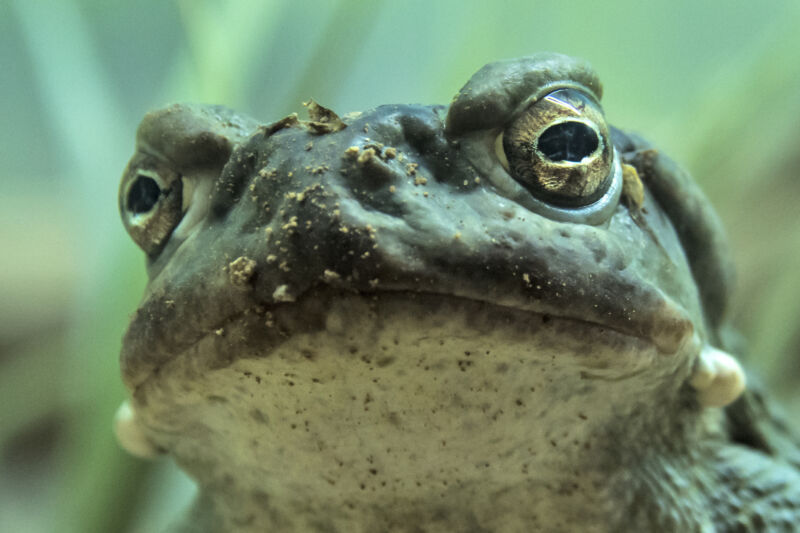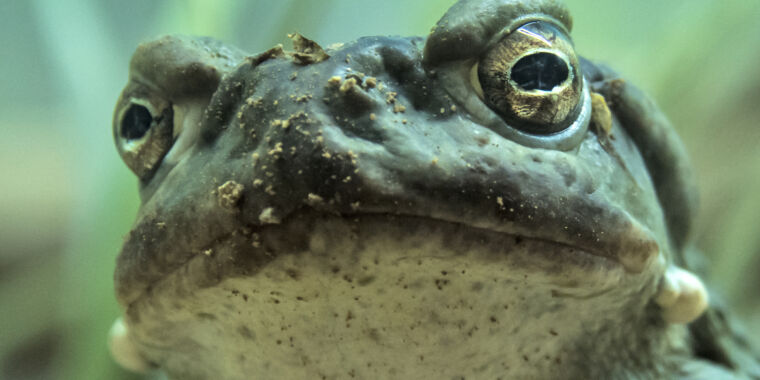Chemical tweaks to a toad hallucinogen turns it into a potential drug
No licking toads! —
Targets a different serotonin receptor from other popular hallucinogens.

Enlarge / The Colorado River toad, also known as the Sonoran Desert Toad.
It is becoming increasingly accepted that classic psychedelics like LSD, psilocybin, ayahuasca, and mescaline can act as antidepressants and anti-anxiety treatments in addition to causing hallucinations. They act by binding to a serotonin receptor. But there are 14 known types of serotonin receptors, and most of the research into these compounds has focused on only one of them—the one these molecules like, called 5-HT2A. (5-HT, short for 5-hydroxytryptamine, is the chemical name for serotonin.)
The Colorado River toad (Incilius alvarius), also known as the Sonoran Desert toad, secretes a psychedelic compound that likes to bind to a different serotonin receptor subtype called 5-HT1A. And that difference may be the key to developing an entirely distinct class of antidepressants.
Uncovering novel biology
Like other psychedelics, the one the toad produces decreases depression and anxiety and induces meaningful and spiritually significant experiences. It has been used clinically to treat vets with post-traumatic stress disorder and is being developed as a treatment for other neurological disorders and drug abuse. 5-HT1A is a validated therapeutic target, as approved drugs, including the antidepressant Viibryd and the anti-anxiety med Buspar, bind to it. But little is known about how psychedelics engage with this receptor and which effects it mediates, so Daniel Wacker’s lab decided to look into it.
The researchers started by making chemical modifications to the frog psychedelic and noting how each of the tweaked molecules bound to both 5-HT2A and 5-HT1A. As a group, these psychedelics are known as “designer tryptamines”—that’s tryp with a “y”, mind you—because they are metabolites of the amino acid tryptophan.
The lab made 10 variants and found one that is more than 800-fold selective about sticking to 5-HT1A as compared to 5-HT2A. That makes it a great research tool for elucidating the structure-activity relationship of the 5-HT1A receptor, as well as the molecular mechanisms behind the pharmacology of the drugs on the market that bind to it. The lab used it to explore both of those avenues. However, the variant’s ultimate utility might be as a new therapeutic for psychiatric disorders, so they tested it in mice.
Improving the lives of mice
The compound did not induce hallucinations in mice, as measured by the “head-twitch response.” But it did alleviate depression, as measured by a “chronic social defeat stress model.” In this model, for 10 days in a row, the experimental mouse was introduced to an “aggressor mouse” for “10-minute defeat bouts”; essentially, it got beat up by a bully at recess for two weeks. Understandably, after this experience, the experimental mouse tended not to be that friendly with new mice, as controls usually are. But when injected with the modified toad psychedelic, the bullied mice were more likely to interact positively with new mice they met.
Depressed mice, like depressed people, also suffer from anhedonia: a reduced ability to experience pleasure. In mice, this manifests in not taking advantage of drinking sugar water when given the opportunity. But treated bullied mice regained their preference for the sweet drink. About a third of mice seem to be “stress-resilient” in this model; the bullying doesn’t seem to phase them. The drug increased the number of resilient mice.
The 5-HT2A receptor has hogged all of the research love because it mediates the hallucinogenic effects of many popular psychedelics, so people assumed that it must mediate their therapeutic effects, too. However, Wacker argues that there is little evidence supporting this assumption. Wacker’s new toad-based psychedelic variant and its preference for the 5-HT1A receptor will help elucidate the complementary roles these two receptor subtypes play in mediating the cellular and psychological effects of psychedelic molecules. And it might provide the basis for a new tryptamine-based mental health treatment as well—one without hallucinatory side effects, disappointing as that may be to some.
Nature, 2024. DOI: 10.1038/s41586-024-07403-2
Chemical tweaks to a toad hallucinogen turns it into a potential drug Read More »
